Deakin University HSH725: Research Literacy Report on Mental Illness
VerifiedAdded on 2022/10/06
|11
|2756
|124
Report
AI Summary
This report focuses on the challenges faced by children with mental illness within the healthcare sector. It examines the difficulties experienced by children and their parents, considering how these challenges have evolved with advancements in healthcare. The report reviews literature on prevalence, treatment, and the impact of mental disorders, emphasizing the roles of healthcare workers and the importance of early diagnosis and intervention, including the use of telehealth. It also addresses public stigma, family support, and the need for best practices in managing children with mental disabilities. The report recommends a shift from traditional treatment methods to patient-centered approaches, like telehealth, to reduce social isolation and discrimination. The conclusion highlights environmental and genetic risk factors, the benefits of early intervention, and the importance of nursing interventions and telemedicine in providing comprehensive care.
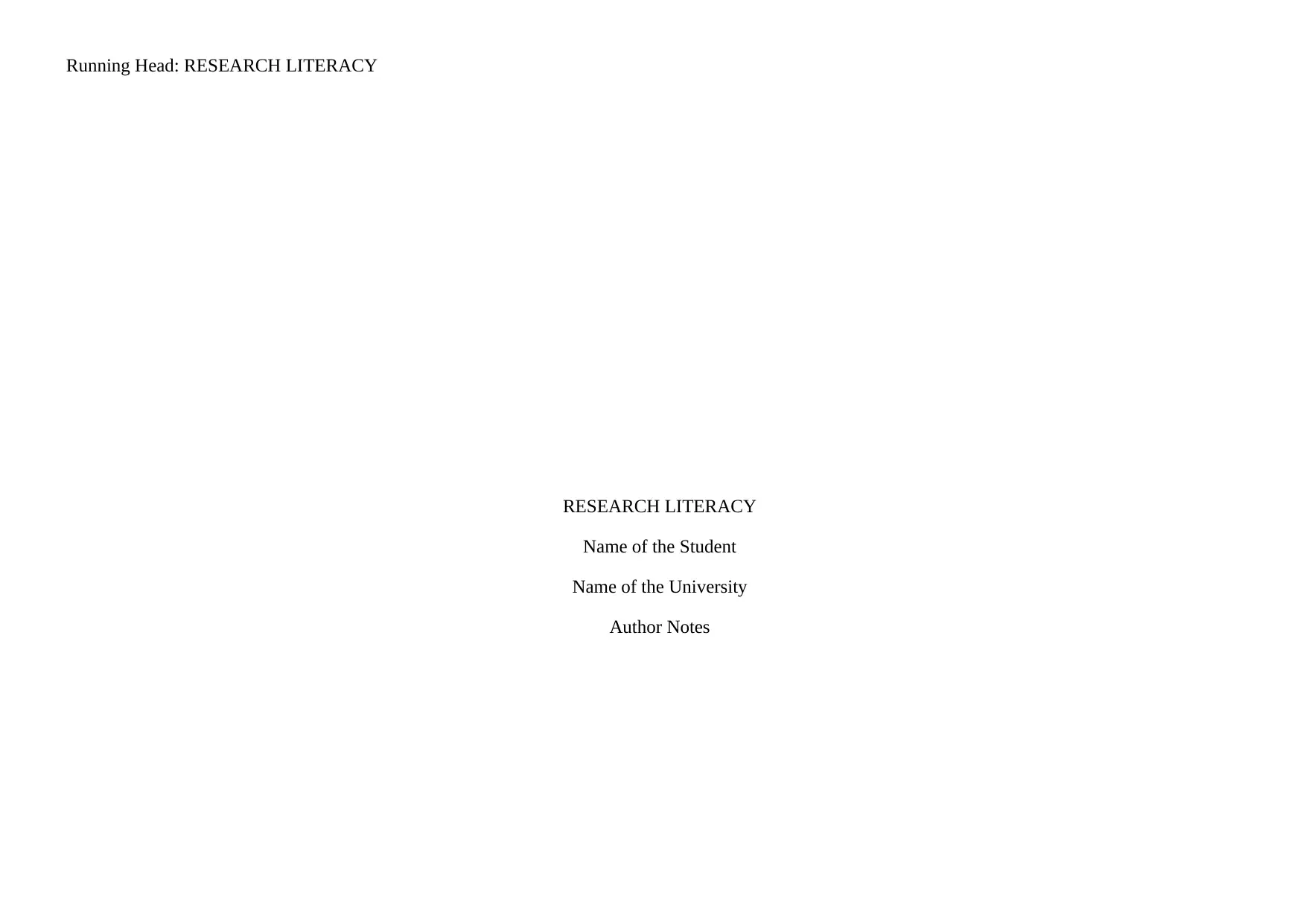
Running Head: RESEARCH LITERACY
RESEARCH LITERACY
Name of the Student
Name of the University
Author Notes
RESEARCH LITERACY
Name of the Student
Name of the University
Author Notes
Paraphrase This Document
Need a fresh take? Get an instant paraphrase of this document with our AI Paraphraser
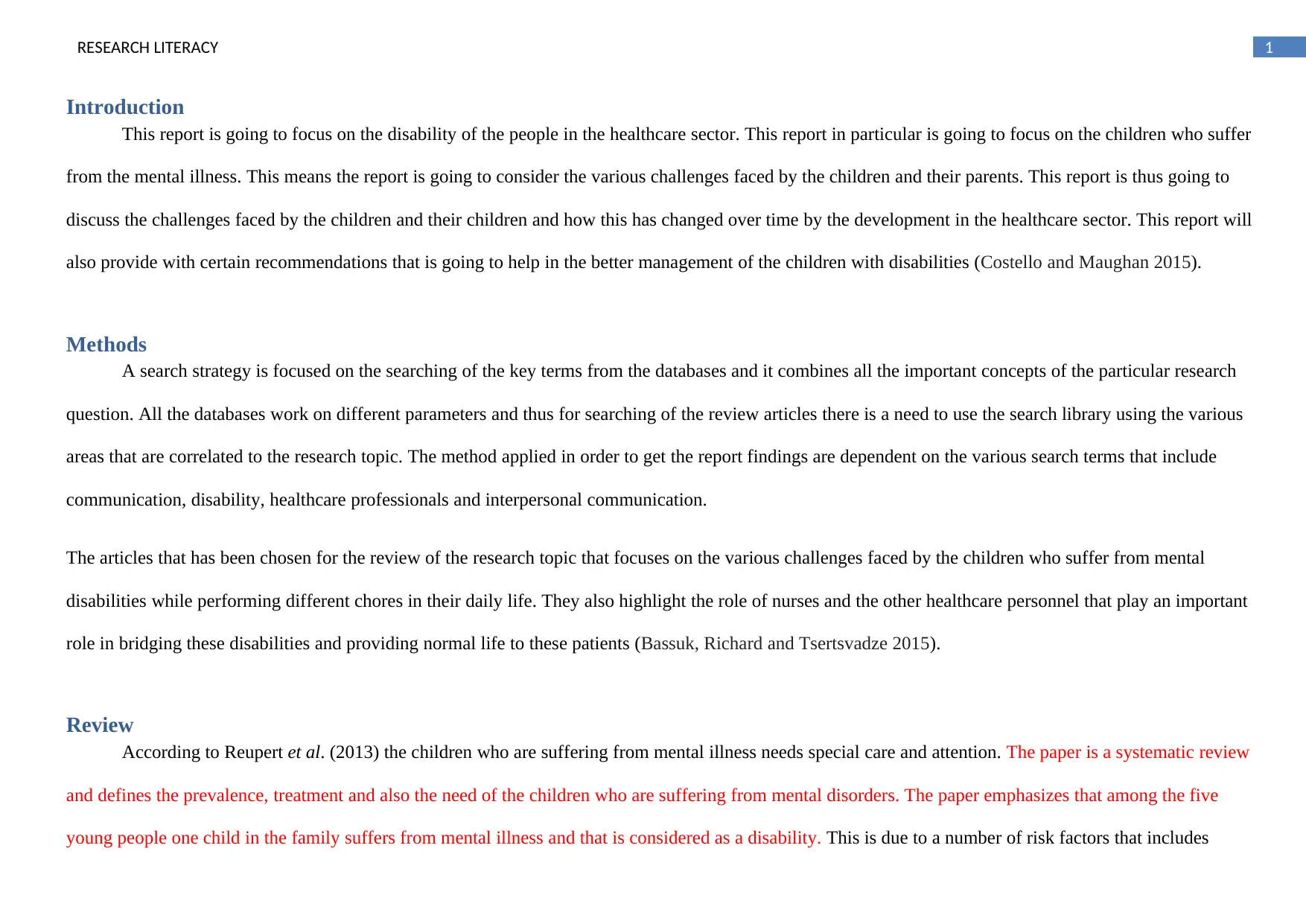
1RESEARCH LITERACY
Introduction
This report is going to focus on the disability of the people in the healthcare sector. This report in particular is going to focus on the children who suffer
from the mental illness. This means the report is going to consider the various challenges faced by the children and their parents. This report is thus going to
discuss the challenges faced by the children and their children and how this has changed over time by the development in the healthcare sector. This report will
also provide with certain recommendations that is going to help in the better management of the children with disabilities (Costello and Maughan 2015).
Methods
A search strategy is focused on the searching of the key terms from the databases and it combines all the important concepts of the particular research
question. All the databases work on different parameters and thus for searching of the review articles there is a need to use the search library using the various
areas that are correlated to the research topic. The method applied in order to get the report findings are dependent on the various search terms that include
communication, disability, healthcare professionals and interpersonal communication.
The articles that has been chosen for the review of the research topic that focuses on the various challenges faced by the children who suffer from mental
disabilities while performing different chores in their daily life. They also highlight the role of nurses and the other healthcare personnel that play an important
role in bridging these disabilities and providing normal life to these patients (Bassuk, Richard and Tsertsvadze 2015).
Review
According to Reupert et al. (2013) the children who are suffering from mental illness needs special care and attention. The paper is a systematic review
and defines the prevalence, treatment and also the need of the children who are suffering from mental disorders. The paper emphasizes that among the five
young people one child in the family suffers from mental illness and that is considered as a disability. This is due to a number of risk factors that includes
Introduction
This report is going to focus on the disability of the people in the healthcare sector. This report in particular is going to focus on the children who suffer
from the mental illness. This means the report is going to consider the various challenges faced by the children and their parents. This report is thus going to
discuss the challenges faced by the children and their children and how this has changed over time by the development in the healthcare sector. This report will
also provide with certain recommendations that is going to help in the better management of the children with disabilities (Costello and Maughan 2015).
Methods
A search strategy is focused on the searching of the key terms from the databases and it combines all the important concepts of the particular research
question. All the databases work on different parameters and thus for searching of the review articles there is a need to use the search library using the various
areas that are correlated to the research topic. The method applied in order to get the report findings are dependent on the various search terms that include
communication, disability, healthcare professionals and interpersonal communication.
The articles that has been chosen for the review of the research topic that focuses on the various challenges faced by the children who suffer from mental
disabilities while performing different chores in their daily life. They also highlight the role of nurses and the other healthcare personnel that play an important
role in bridging these disabilities and providing normal life to these patients (Bassuk, Richard and Tsertsvadze 2015).
Review
According to Reupert et al. (2013) the children who are suffering from mental illness needs special care and attention. The paper is a systematic review
and defines the prevalence, treatment and also the need of the children who are suffering from mental disorders. The paper emphasizes that among the five
young people one child in the family suffers from mental illness and that is considered as a disability. This is due to a number of risk factors that includes
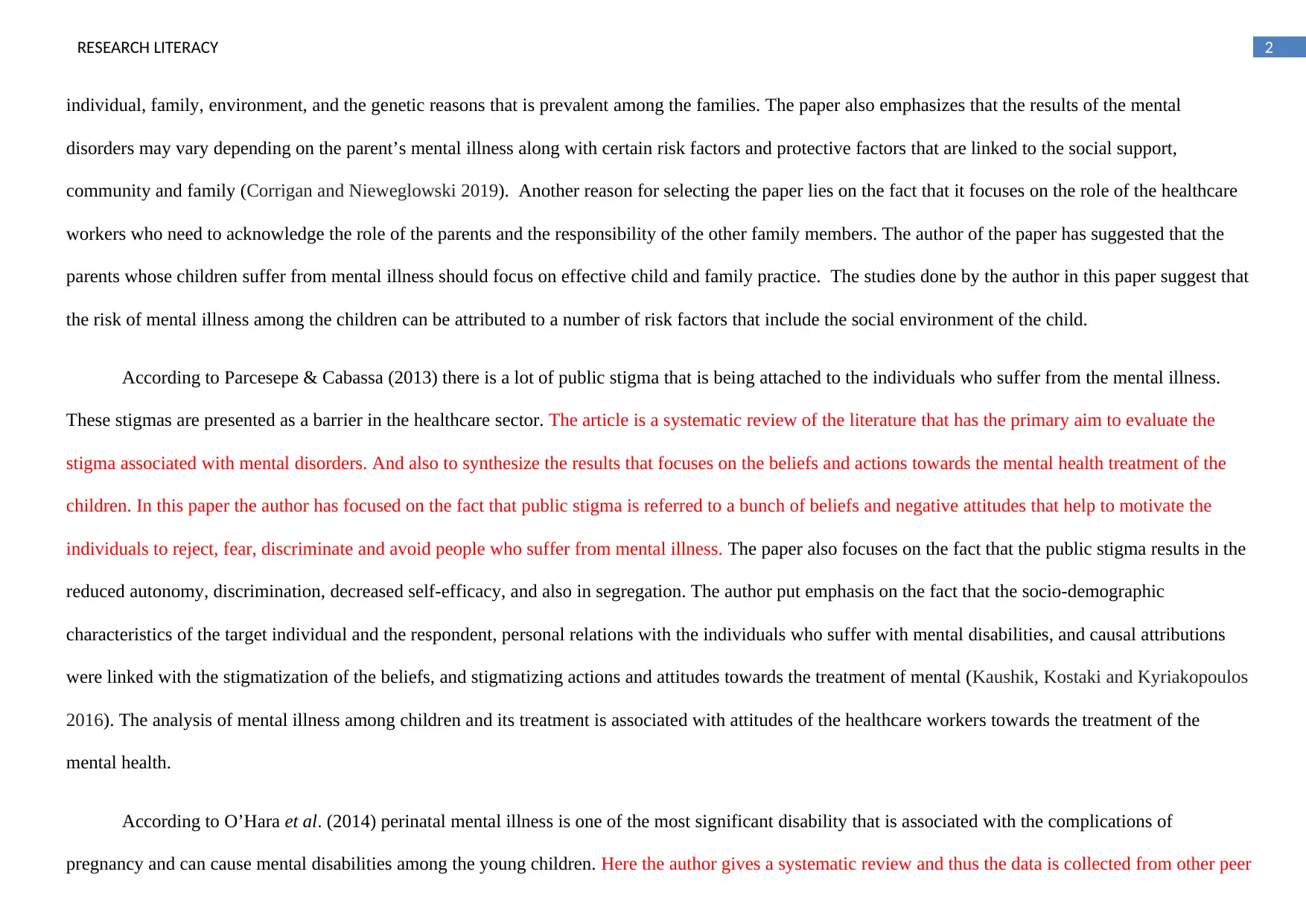
2RESEARCH LITERACY
individual, family, environment, and the genetic reasons that is prevalent among the families. The paper also emphasizes that the results of the mental
disorders may vary depending on the parent’s mental illness along with certain risk factors and protective factors that are linked to the social support,
community and family (Corrigan and Nieweglowski 2019). Another reason for selecting the paper lies on the fact that it focuses on the role of the healthcare
workers who need to acknowledge the role of the parents and the responsibility of the other family members. The author of the paper has suggested that the
parents whose children suffer from mental illness should focus on effective child and family practice. The studies done by the author in this paper suggest that
the risk of mental illness among the children can be attributed to a number of risk factors that include the social environment of the child.
According to Parcesepe & Cabassa (2013) there is a lot of public stigma that is being attached to the individuals who suffer from the mental illness.
These stigmas are presented as a barrier in the healthcare sector. The article is a systematic review of the literature that has the primary aim to evaluate the
stigma associated with mental disorders. And also to synthesize the results that focuses on the beliefs and actions towards the mental health treatment of the
children. In this paper the author has focused on the fact that public stigma is referred to a bunch of beliefs and negative attitudes that help to motivate the
individuals to reject, fear, discriminate and avoid people who suffer from mental illness. The paper also focuses on the fact that the public stigma results in the
reduced autonomy, discrimination, decreased self-efficacy, and also in segregation. The author put emphasis on the fact that the socio-demographic
characteristics of the target individual and the respondent, personal relations with the individuals who suffer with mental disabilities, and causal attributions
were linked with the stigmatization of the beliefs, and stigmatizing actions and attitudes towards the treatment of mental (Kaushik, Kostaki and Kyriakopoulos
2016). The analysis of mental illness among children and its treatment is associated with attitudes of the healthcare workers towards the treatment of the
mental health.
According to O’Hara et al. (2014) perinatal mental illness is one of the most significant disability that is associated with the complications of
pregnancy and can cause mental disabilities among the young children. Here the author gives a systematic review and thus the data is collected from other peer
individual, family, environment, and the genetic reasons that is prevalent among the families. The paper also emphasizes that the results of the mental
disorders may vary depending on the parent’s mental illness along with certain risk factors and protective factors that are linked to the social support,
community and family (Corrigan and Nieweglowski 2019). Another reason for selecting the paper lies on the fact that it focuses on the role of the healthcare
workers who need to acknowledge the role of the parents and the responsibility of the other family members. The author of the paper has suggested that the
parents whose children suffer from mental illness should focus on effective child and family practice. The studies done by the author in this paper suggest that
the risk of mental illness among the children can be attributed to a number of risk factors that include the social environment of the child.
According to Parcesepe & Cabassa (2013) there is a lot of public stigma that is being attached to the individuals who suffer from the mental illness.
These stigmas are presented as a barrier in the healthcare sector. The article is a systematic review of the literature that has the primary aim to evaluate the
stigma associated with mental disorders. And also to synthesize the results that focuses on the beliefs and actions towards the mental health treatment of the
children. In this paper the author has focused on the fact that public stigma is referred to a bunch of beliefs and negative attitudes that help to motivate the
individuals to reject, fear, discriminate and avoid people who suffer from mental illness. The paper also focuses on the fact that the public stigma results in the
reduced autonomy, discrimination, decreased self-efficacy, and also in segregation. The author put emphasis on the fact that the socio-demographic
characteristics of the target individual and the respondent, personal relations with the individuals who suffer with mental disabilities, and causal attributions
were linked with the stigmatization of the beliefs, and stigmatizing actions and attitudes towards the treatment of mental (Kaushik, Kostaki and Kyriakopoulos
2016). The analysis of mental illness among children and its treatment is associated with attitudes of the healthcare workers towards the treatment of the
mental health.
According to O’Hara et al. (2014) perinatal mental illness is one of the most significant disability that is associated with the complications of
pregnancy and can cause mental disabilities among the young children. Here the author gives a systematic review and thus the data is collected from other peer
⊘ This is a preview!⊘
Do you want full access?
Subscribe today to unlock all pages.

Trusted by 1+ million students worldwide
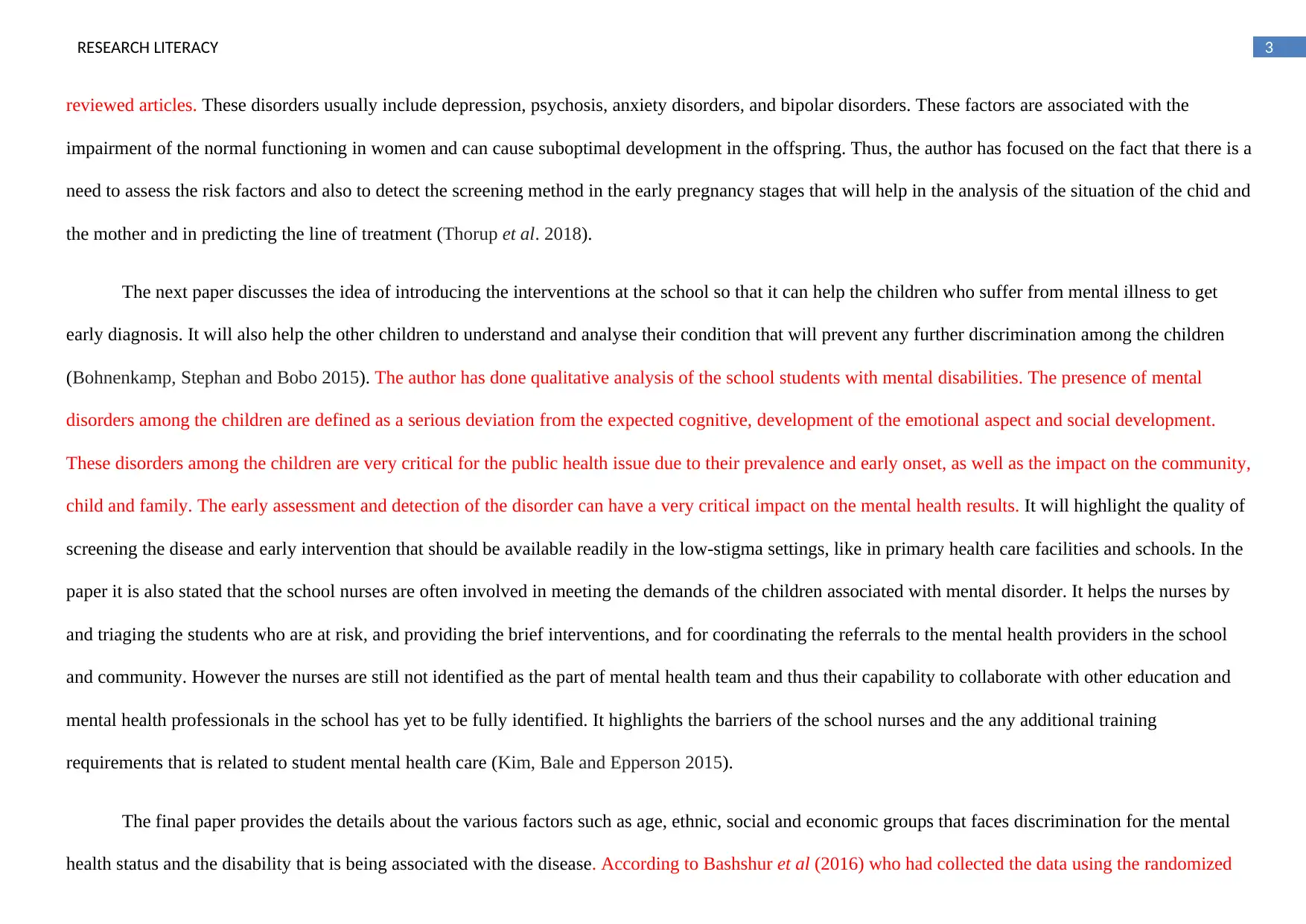
3RESEARCH LITERACY
reviewed articles. These disorders usually include depression, psychosis, anxiety disorders, and bipolar disorders. These factors are associated with the
impairment of the normal functioning in women and can cause suboptimal development in the offspring. Thus, the author has focused on the fact that there is a
need to assess the risk factors and also to detect the screening method in the early pregnancy stages that will help in the analysis of the situation of the chid and
the mother and in predicting the line of treatment (Thorup et al. 2018).
The next paper discusses the idea of introducing the interventions at the school so that it can help the children who suffer from mental illness to get
early diagnosis. It will also help the other children to understand and analyse their condition that will prevent any further discrimination among the children
(Bohnenkamp, Stephan and Bobo 2015). The author has done qualitative analysis of the school students with mental disabilities. The presence of mental
disorders among the children are defined as a serious deviation from the expected cognitive, development of the emotional aspect and social development.
These disorders among the children are very critical for the public health issue due to their prevalence and early onset, as well as the impact on the community,
child and family. The early assessment and detection of the disorder can have a very critical impact on the mental health results. It will highlight the quality of
screening the disease and early intervention that should be available readily in the low-stigma settings, like in primary health care facilities and schools. In the
paper it is also stated that the school nurses are often involved in meeting the demands of the children associated with mental disorder. It helps the nurses by
and triaging the students who are at risk, and providing the brief interventions, and for coordinating the referrals to the mental health providers in the school
and community. However the nurses are still not identified as the part of mental health team and thus their capability to collaborate with other education and
mental health professionals in the school has yet to be fully identified. It highlights the barriers of the school nurses and the any additional training
requirements that is related to student mental health care (Kim, Bale and Epperson 2015).
The final paper provides the details about the various factors such as age, ethnic, social and economic groups that faces discrimination for the mental
health status and the disability that is being associated with the disease. According to Bashshur et al (2016) who had collected the data using the randomized
reviewed articles. These disorders usually include depression, psychosis, anxiety disorders, and bipolar disorders. These factors are associated with the
impairment of the normal functioning in women and can cause suboptimal development in the offspring. Thus, the author has focused on the fact that there is a
need to assess the risk factors and also to detect the screening method in the early pregnancy stages that will help in the analysis of the situation of the chid and
the mother and in predicting the line of treatment (Thorup et al. 2018).
The next paper discusses the idea of introducing the interventions at the school so that it can help the children who suffer from mental illness to get
early diagnosis. It will also help the other children to understand and analyse their condition that will prevent any further discrimination among the children
(Bohnenkamp, Stephan and Bobo 2015). The author has done qualitative analysis of the school students with mental disabilities. The presence of mental
disorders among the children are defined as a serious deviation from the expected cognitive, development of the emotional aspect and social development.
These disorders among the children are very critical for the public health issue due to their prevalence and early onset, as well as the impact on the community,
child and family. The early assessment and detection of the disorder can have a very critical impact on the mental health results. It will highlight the quality of
screening the disease and early intervention that should be available readily in the low-stigma settings, like in primary health care facilities and schools. In the
paper it is also stated that the school nurses are often involved in meeting the demands of the children associated with mental disorder. It helps the nurses by
and triaging the students who are at risk, and providing the brief interventions, and for coordinating the referrals to the mental health providers in the school
and community. However the nurses are still not identified as the part of mental health team and thus their capability to collaborate with other education and
mental health professionals in the school has yet to be fully identified. It highlights the barriers of the school nurses and the any additional training
requirements that is related to student mental health care (Kim, Bale and Epperson 2015).
The final paper provides the details about the various factors such as age, ethnic, social and economic groups that faces discrimination for the mental
health status and the disability that is being associated with the disease. According to Bashshur et al (2016) who had collected the data using the randomized
Paraphrase This Document
Need a fresh take? Get an instant paraphrase of this document with our AI Paraphraser
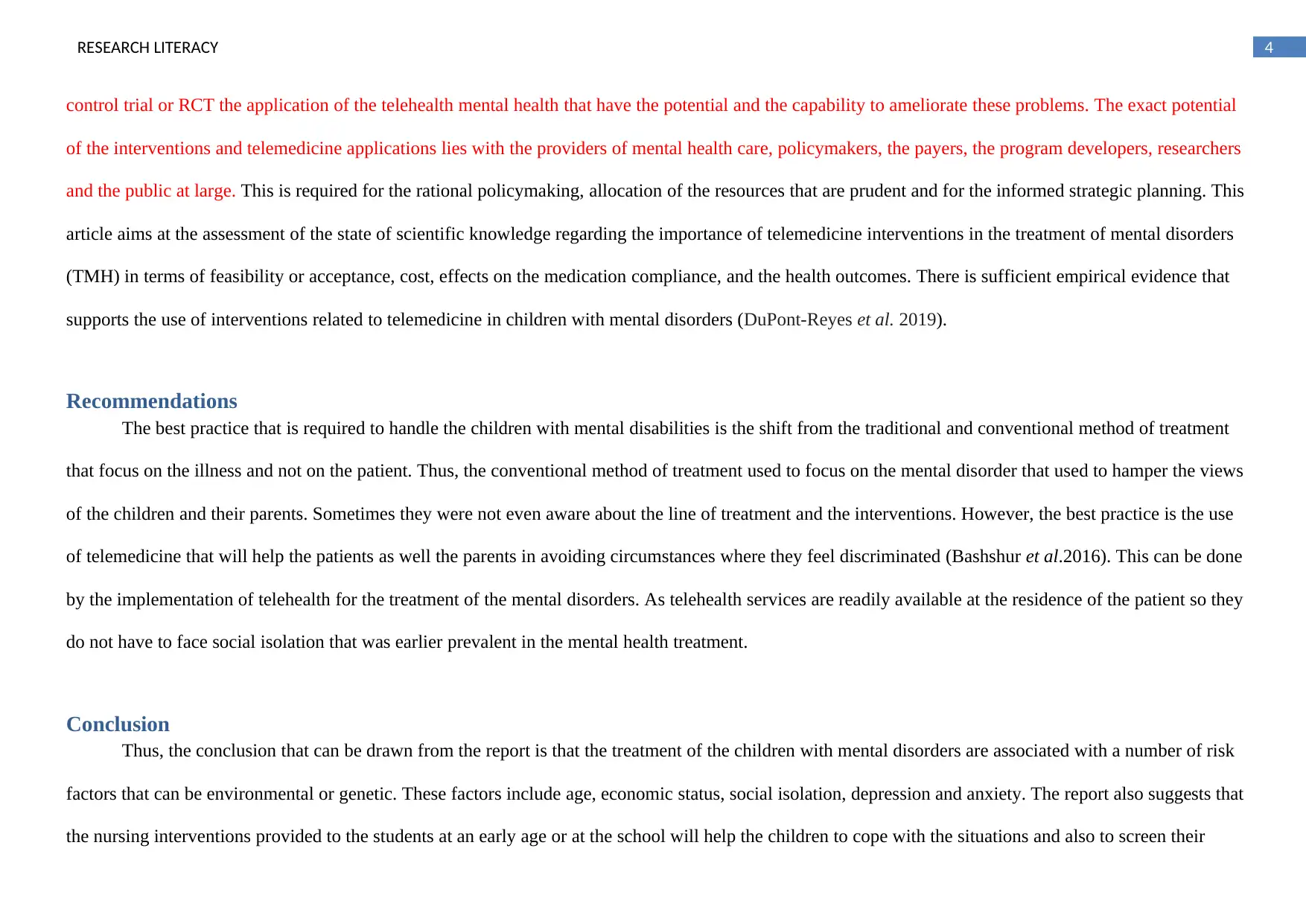
4RESEARCH LITERACY
control trial or RCT the application of the telehealth mental health that have the potential and the capability to ameliorate these problems. The exact potential
of the interventions and telemedicine applications lies with the providers of mental health care, policymakers, the payers, the program developers, researchers
and the public at large. This is required for the rational policymaking, allocation of the resources that are prudent and for the informed strategic planning. This
article aims at the assessment of the state of scientific knowledge regarding the importance of telemedicine interventions in the treatment of mental disorders
(TMH) in terms of feasibility or acceptance, cost, effects on the medication compliance, and the health outcomes. There is sufficient empirical evidence that
supports the use of interventions related to telemedicine in children with mental disorders (DuPont-Reyes et al. 2019).
Recommendations
The best practice that is required to handle the children with mental disabilities is the shift from the traditional and conventional method of treatment
that focus on the illness and not on the patient. Thus, the conventional method of treatment used to focus on the mental disorder that used to hamper the views
of the children and their parents. Sometimes they were not even aware about the line of treatment and the interventions. However, the best practice is the use
of telemedicine that will help the patients as well the parents in avoiding circumstances where they feel discriminated (Bashshur et al.2016). This can be done
by the implementation of telehealth for the treatment of the mental disorders. As telehealth services are readily available at the residence of the patient so they
do not have to face social isolation that was earlier prevalent in the mental health treatment.
Conclusion
Thus, the conclusion that can be drawn from the report is that the treatment of the children with mental disorders are associated with a number of risk
factors that can be environmental or genetic. These factors include age, economic status, social isolation, depression and anxiety. The report also suggests that
the nursing interventions provided to the students at an early age or at the school will help the children to cope with the situations and also to screen their
control trial or RCT the application of the telehealth mental health that have the potential and the capability to ameliorate these problems. The exact potential
of the interventions and telemedicine applications lies with the providers of mental health care, policymakers, the payers, the program developers, researchers
and the public at large. This is required for the rational policymaking, allocation of the resources that are prudent and for the informed strategic planning. This
article aims at the assessment of the state of scientific knowledge regarding the importance of telemedicine interventions in the treatment of mental disorders
(TMH) in terms of feasibility or acceptance, cost, effects on the medication compliance, and the health outcomes. There is sufficient empirical evidence that
supports the use of interventions related to telemedicine in children with mental disorders (DuPont-Reyes et al. 2019).
Recommendations
The best practice that is required to handle the children with mental disabilities is the shift from the traditional and conventional method of treatment
that focus on the illness and not on the patient. Thus, the conventional method of treatment used to focus on the mental disorder that used to hamper the views
of the children and their parents. Sometimes they were not even aware about the line of treatment and the interventions. However, the best practice is the use
of telemedicine that will help the patients as well the parents in avoiding circumstances where they feel discriminated (Bashshur et al.2016). This can be done
by the implementation of telehealth for the treatment of the mental disorders. As telehealth services are readily available at the residence of the patient so they
do not have to face social isolation that was earlier prevalent in the mental health treatment.
Conclusion
Thus, the conclusion that can be drawn from the report is that the treatment of the children with mental disorders are associated with a number of risk
factors that can be environmental or genetic. These factors include age, economic status, social isolation, depression and anxiety. The report also suggests that
the nursing interventions provided to the students at an early age or at the school will help the children to cope with the situations and also to screen their
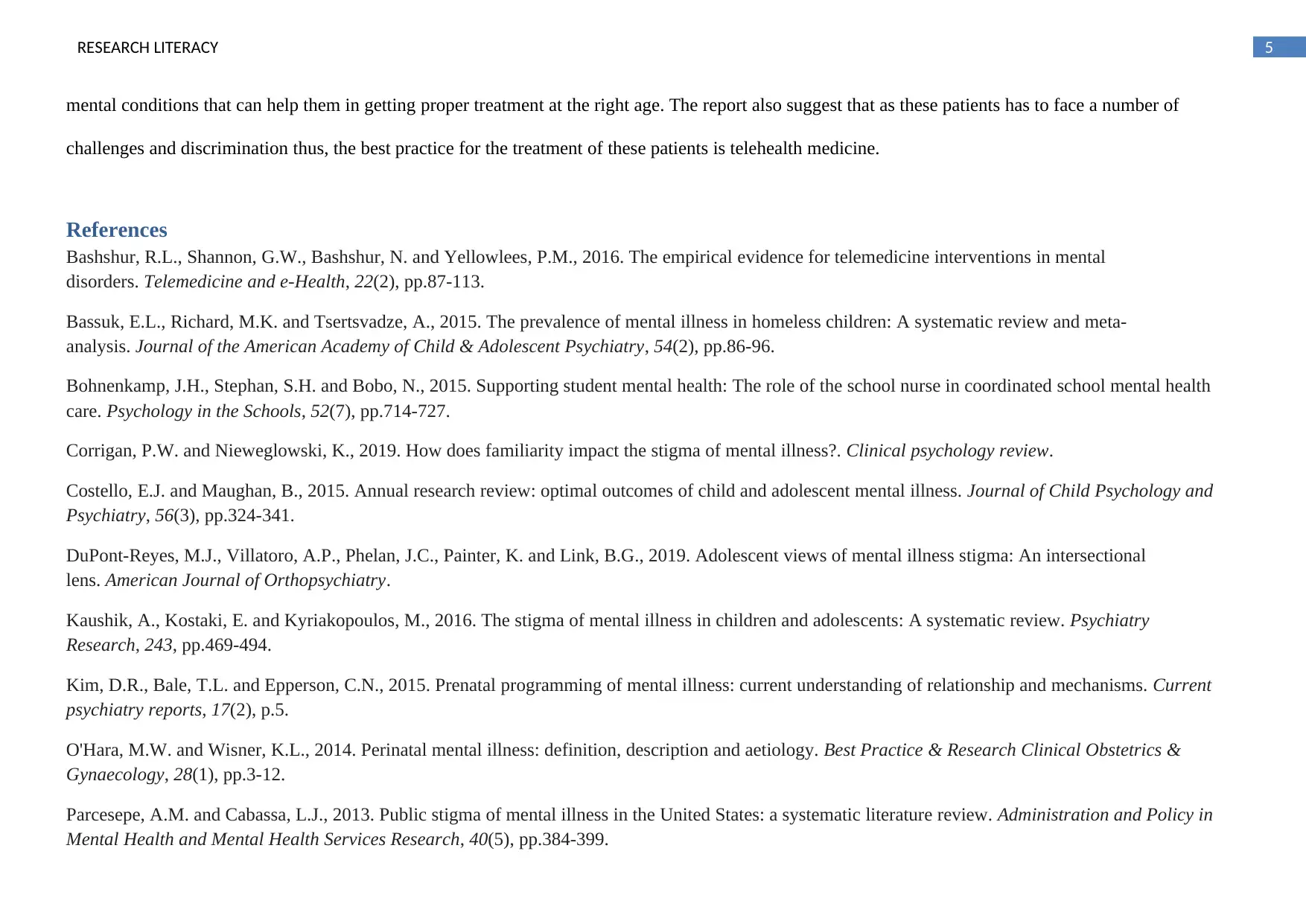
5RESEARCH LITERACY
mental conditions that can help them in getting proper treatment at the right age. The report also suggest that as these patients has to face a number of
challenges and discrimination thus, the best practice for the treatment of these patients is telehealth medicine.
References
Bashshur, R.L., Shannon, G.W., Bashshur, N. and Yellowlees, P.M., 2016. The empirical evidence for telemedicine interventions in mental
disorders. Telemedicine and e-Health, 22(2), pp.87-113.
Bassuk, E.L., Richard, M.K. and Tsertsvadze, A., 2015. The prevalence of mental illness in homeless children: A systematic review and meta-
analysis. Journal of the American Academy of Child & Adolescent Psychiatry, 54(2), pp.86-96.
Bohnenkamp, J.H., Stephan, S.H. and Bobo, N., 2015. Supporting student mental health: The role of the school nurse in coordinated school mental health
care. Psychology in the Schools, 52(7), pp.714-727.
Corrigan, P.W. and Nieweglowski, K., 2019. How does familiarity impact the stigma of mental illness?. Clinical psychology review.
Costello, E.J. and Maughan, B., 2015. Annual research review: optimal outcomes of child and adolescent mental illness. Journal of Child Psychology and
Psychiatry, 56(3), pp.324-341.
DuPont-Reyes, M.J., Villatoro, A.P., Phelan, J.C., Painter, K. and Link, B.G., 2019. Adolescent views of mental illness stigma: An intersectional
lens. American Journal of Orthopsychiatry.
Kaushik, A., Kostaki, E. and Kyriakopoulos, M., 2016. The stigma of mental illness in children and adolescents: A systematic review. Psychiatry
Research, 243, pp.469-494.
Kim, D.R., Bale, T.L. and Epperson, C.N., 2015. Prenatal programming of mental illness: current understanding of relationship and mechanisms. Current
psychiatry reports, 17(2), p.5.
O'Hara, M.W. and Wisner, K.L., 2014. Perinatal mental illness: definition, description and aetiology. Best Practice & Research Clinical Obstetrics &
Gynaecology, 28(1), pp.3-12.
Parcesepe, A.M. and Cabassa, L.J., 2013. Public stigma of mental illness in the United States: a systematic literature review. Administration and Policy in
Mental Health and Mental Health Services Research, 40(5), pp.384-399.
mental conditions that can help them in getting proper treatment at the right age. The report also suggest that as these patients has to face a number of
challenges and discrimination thus, the best practice for the treatment of these patients is telehealth medicine.
References
Bashshur, R.L., Shannon, G.W., Bashshur, N. and Yellowlees, P.M., 2016. The empirical evidence for telemedicine interventions in mental
disorders. Telemedicine and e-Health, 22(2), pp.87-113.
Bassuk, E.L., Richard, M.K. and Tsertsvadze, A., 2015. The prevalence of mental illness in homeless children: A systematic review and meta-
analysis. Journal of the American Academy of Child & Adolescent Psychiatry, 54(2), pp.86-96.
Bohnenkamp, J.H., Stephan, S.H. and Bobo, N., 2015. Supporting student mental health: The role of the school nurse in coordinated school mental health
care. Psychology in the Schools, 52(7), pp.714-727.
Corrigan, P.W. and Nieweglowski, K., 2019. How does familiarity impact the stigma of mental illness?. Clinical psychology review.
Costello, E.J. and Maughan, B., 2015. Annual research review: optimal outcomes of child and adolescent mental illness. Journal of Child Psychology and
Psychiatry, 56(3), pp.324-341.
DuPont-Reyes, M.J., Villatoro, A.P., Phelan, J.C., Painter, K. and Link, B.G., 2019. Adolescent views of mental illness stigma: An intersectional
lens. American Journal of Orthopsychiatry.
Kaushik, A., Kostaki, E. and Kyriakopoulos, M., 2016. The stigma of mental illness in children and adolescents: A systematic review. Psychiatry
Research, 243, pp.469-494.
Kim, D.R., Bale, T.L. and Epperson, C.N., 2015. Prenatal programming of mental illness: current understanding of relationship and mechanisms. Current
psychiatry reports, 17(2), p.5.
O'Hara, M.W. and Wisner, K.L., 2014. Perinatal mental illness: definition, description and aetiology. Best Practice & Research Clinical Obstetrics &
Gynaecology, 28(1), pp.3-12.
Parcesepe, A.M. and Cabassa, L.J., 2013. Public stigma of mental illness in the United States: a systematic literature review. Administration and Policy in
Mental Health and Mental Health Services Research, 40(5), pp.384-399.
⊘ This is a preview!⊘
Do you want full access?
Subscribe today to unlock all pages.

Trusted by 1+ million students worldwide
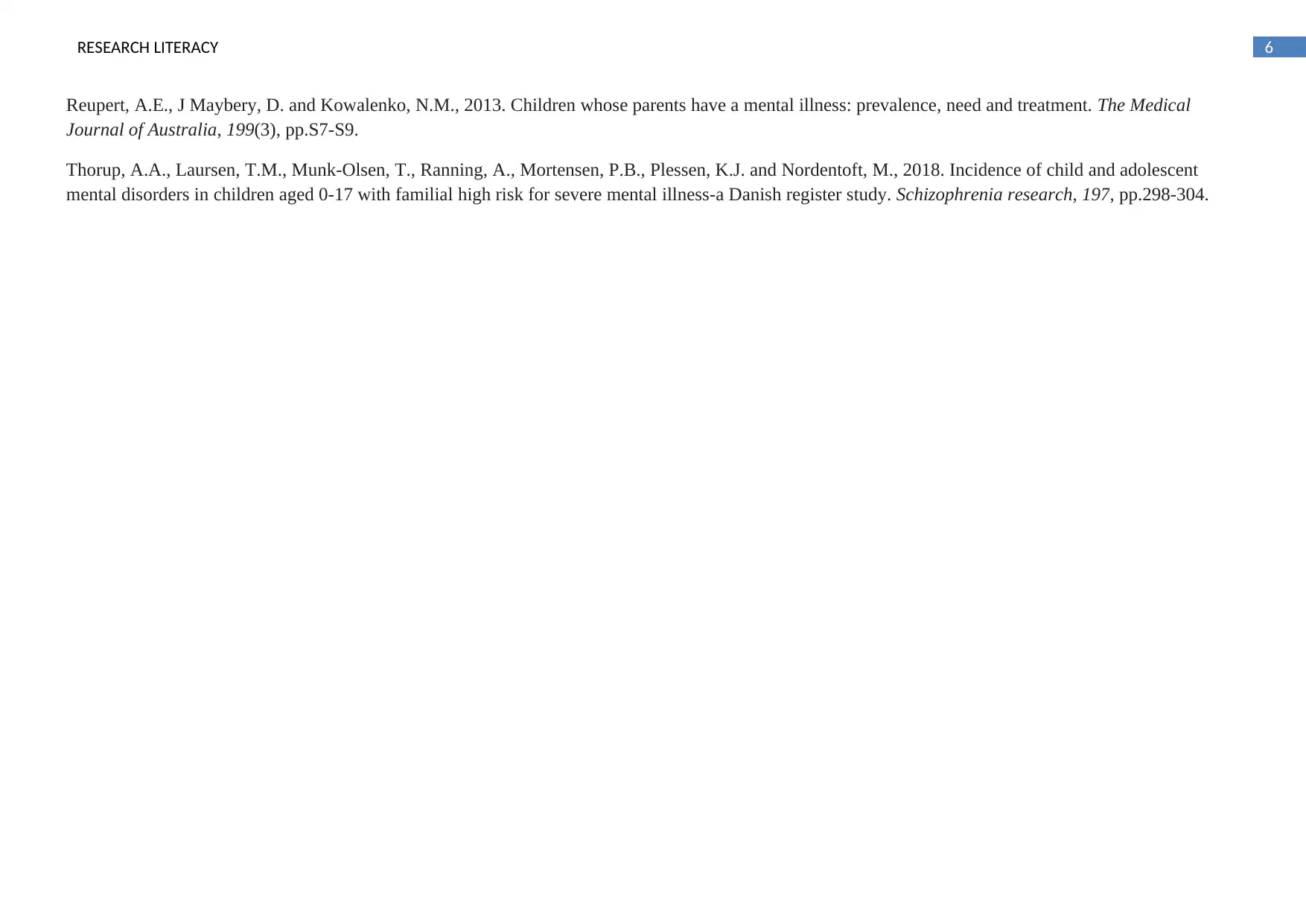
6RESEARCH LITERACY
Reupert, A.E., J Maybery, D. and Kowalenko, N.M., 2013. Children whose parents have a mental illness: prevalence, need and treatment. The Medical
Journal of Australia, 199(3), pp.S7-S9.
Thorup, A.A., Laursen, T.M., Munk-Olsen, T., Ranning, A., Mortensen, P.B., Plessen, K.J. and Nordentoft, M., 2018. Incidence of child and adolescent
mental disorders in children aged 0-17 with familial high risk for severe mental illness-a Danish register study. Schizophrenia research, 197, pp.298-304.
Reupert, A.E., J Maybery, D. and Kowalenko, N.M., 2013. Children whose parents have a mental illness: prevalence, need and treatment. The Medical
Journal of Australia, 199(3), pp.S7-S9.
Thorup, A.A., Laursen, T.M., Munk-Olsen, T., Ranning, A., Mortensen, P.B., Plessen, K.J. and Nordentoft, M., 2018. Incidence of child and adolescent
mental disorders in children aged 0-17 with familial high risk for severe mental illness-a Danish register study. Schizophrenia research, 197, pp.298-304.
Paraphrase This Document
Need a fresh take? Get an instant paraphrase of this document with our AI Paraphraser
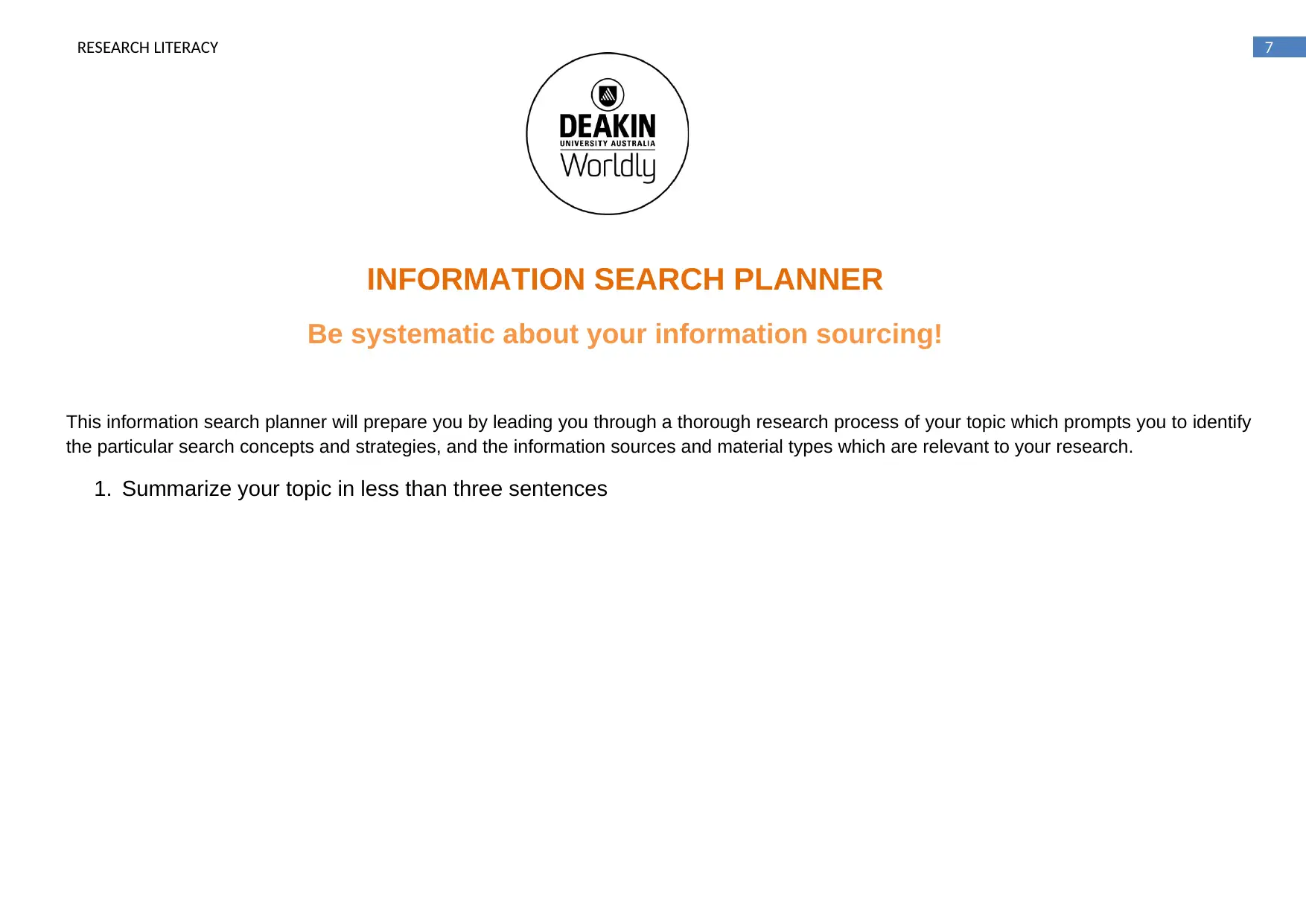
7RESEARCH LITERACY
This information search planner will prepare you by leading you through a thorough research process of your topic which prompts you to identify
the particular search concepts and strategies, and the information sources and material types which are relevant to your research.
1. Summarize your topic in less than three sentences
INFORMATION SEARCH PLANNER
Be systematic about your information sourcing!
This information search planner will prepare you by leading you through a thorough research process of your topic which prompts you to identify
the particular search concepts and strategies, and the information sources and material types which are relevant to your research.
1. Summarize your topic in less than three sentences
INFORMATION SEARCH PLANNER
Be systematic about your information sourcing!
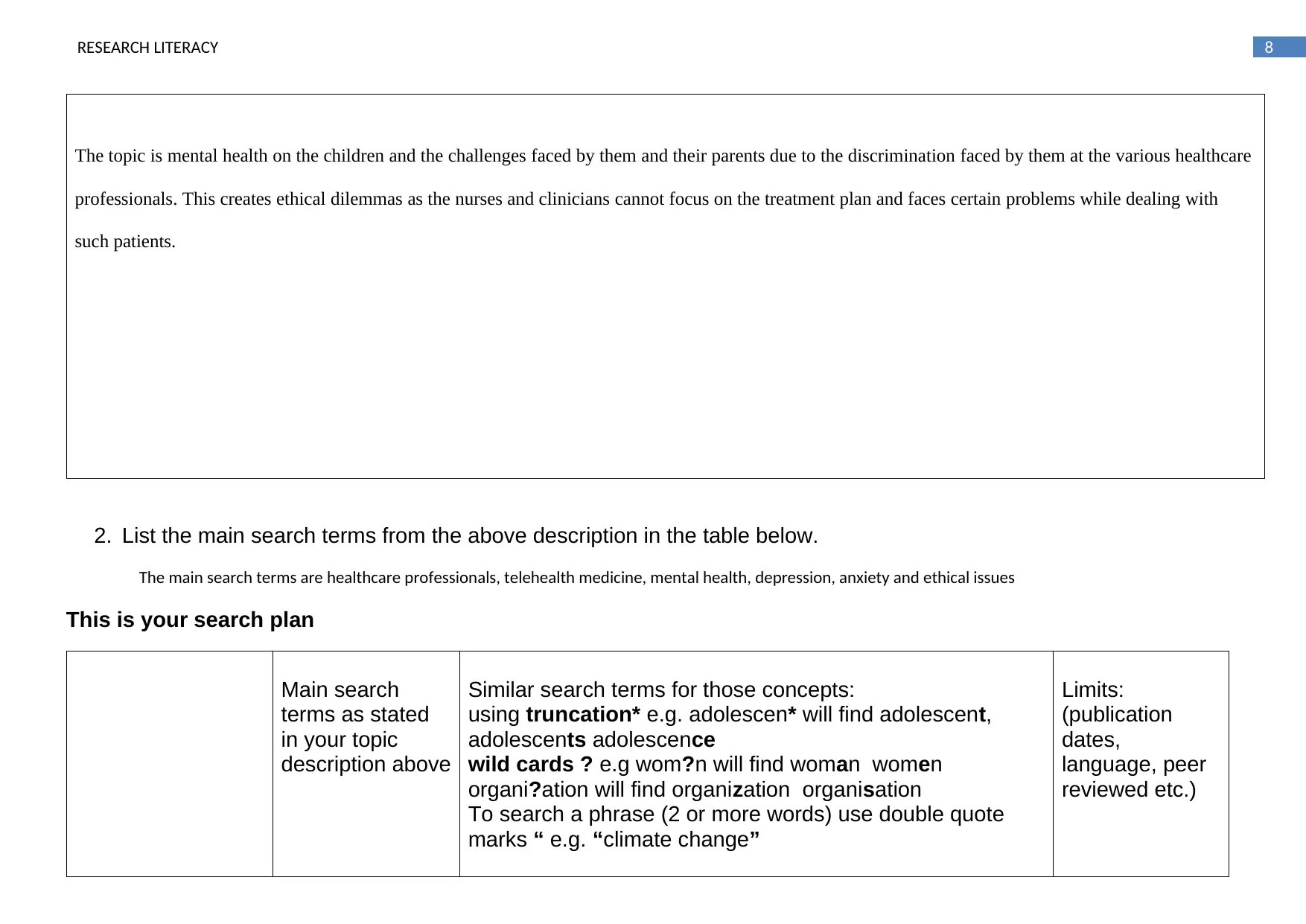
8RESEARCH LITERACY
The topic is mental health on the children and the challenges faced by them and their parents due to the discrimination faced by them at the various healthcare
professionals. This creates ethical dilemmas as the nurses and clinicians cannot focus on the treatment plan and faces certain problems while dealing with
such patients.
2. List the main search terms from the above description in the table below.
The main search terms are healthcare professionals, telehealth medicine, mental health, depression, anxiety and ethical issues
This is your search plan
Main search
terms as stated
in your topic
description above
Similar search terms for those concepts:
using truncation* e.g. adolescen* will find adolescent,
adolescents adolescence
wild cards ? e.g wom?n will find woman women
organi?ation will find organization organisation
To search a phrase (2 or more words) use double quote
marks “ e.g. “climate change”
Limits:
(publication
dates,
language, peer
reviewed etc.)
The topic is mental health on the children and the challenges faced by them and their parents due to the discrimination faced by them at the various healthcare
professionals. This creates ethical dilemmas as the nurses and clinicians cannot focus on the treatment plan and faces certain problems while dealing with
such patients.
2. List the main search terms from the above description in the table below.
The main search terms are healthcare professionals, telehealth medicine, mental health, depression, anxiety and ethical issues
This is your search plan
Main search
terms as stated
in your topic
description above
Similar search terms for those concepts:
using truncation* e.g. adolescen* will find adolescent,
adolescents adolescence
wild cards ? e.g wom?n will find woman women
organi?ation will find organization organisation
To search a phrase (2 or more words) use double quote
marks “ e.g. “climate change”
Limits:
(publication
dates,
language, peer
reviewed etc.)
⊘ This is a preview!⊘
Do you want full access?
Subscribe today to unlock all pages.

Trusted by 1+ million students worldwide
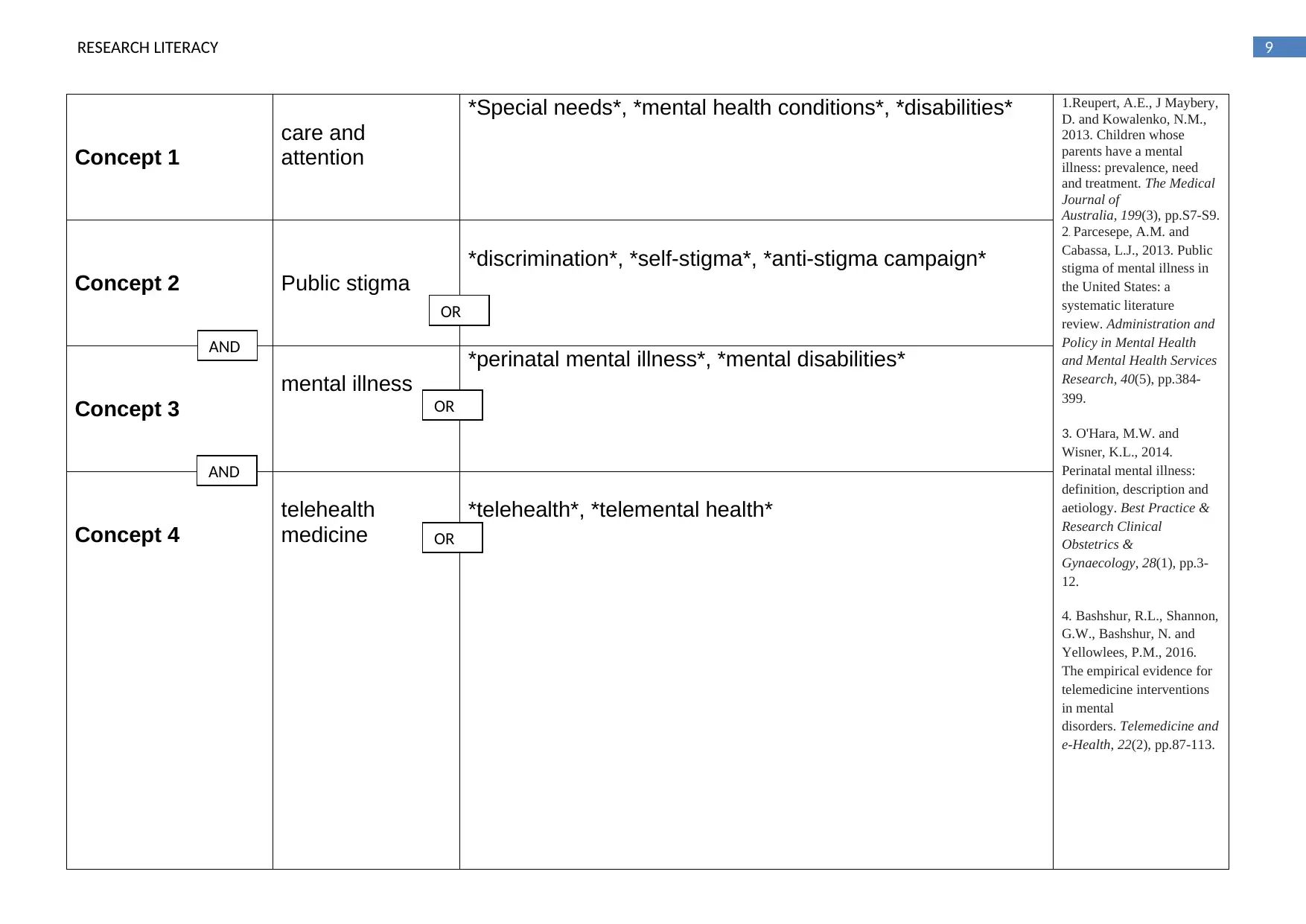
9RESEARCH LITERACY
Concept 1
care and
attention
*Special needs*, *mental health conditions*, *disabilities* 1.Reupert, A.E., J Maybery,
D. and Kowalenko, N.M.,
2013. Children whose
parents have a mental
illness: prevalence, need
and treatment. The Medical
Journal of
Australia, 199(3), pp.S7-S9.
2. Parcesepe, A.M. and
Cabassa, L.J., 2013. Public
stigma of mental illness in
the United States: a
systematic literature
review. Administration and
Policy in Mental Health
and Mental Health Services
Research, 40(5), pp.384-
399.
3. O'Hara, M.W. and
Wisner, K.L., 2014.
Perinatal mental illness:
definition, description and
aetiology. Best Practice &
Research Clinical
Obstetrics &
Gynaecology, 28(1), pp.3-
12.
4. Bashshur, R.L., Shannon,
G.W., Bashshur, N. and
Yellowlees, P.M., 2016.
The empirical evidence for
telemedicine interventions
in mental
disorders. Telemedicine and
e-Health, 22(2), pp.87-113.
Concept 2 Public stigma
*discrimination*, *self-stigma*, *anti-stigma campaign*
Concept 3
mental illness
*perinatal mental illness*, *mental disabilities*
Concept 4
telehealth
medicine
*telehealth*, *telemental health*
AND
AND
OR
OR
OR
Concept 1
care and
attention
*Special needs*, *mental health conditions*, *disabilities* 1.Reupert, A.E., J Maybery,
D. and Kowalenko, N.M.,
2013. Children whose
parents have a mental
illness: prevalence, need
and treatment. The Medical
Journal of
Australia, 199(3), pp.S7-S9.
2. Parcesepe, A.M. and
Cabassa, L.J., 2013. Public
stigma of mental illness in
the United States: a
systematic literature
review. Administration and
Policy in Mental Health
and Mental Health Services
Research, 40(5), pp.384-
399.
3. O'Hara, M.W. and
Wisner, K.L., 2014.
Perinatal mental illness:
definition, description and
aetiology. Best Practice &
Research Clinical
Obstetrics &
Gynaecology, 28(1), pp.3-
12.
4. Bashshur, R.L., Shannon,
G.W., Bashshur, N. and
Yellowlees, P.M., 2016.
The empirical evidence for
telemedicine interventions
in mental
disorders. Telemedicine and
e-Health, 22(2), pp.87-113.
Concept 2 Public stigma
*discrimination*, *self-stigma*, *anti-stigma campaign*
Concept 3
mental illness
*perinatal mental illness*, *mental disabilities*
Concept 4
telehealth
medicine
*telehealth*, *telemental health*
AND
AND
OR
OR
OR
Paraphrase This Document
Need a fresh take? Get an instant paraphrase of this document with our AI Paraphraser

10RESEARCH LITERACY
1 out of 11
Related Documents
Your All-in-One AI-Powered Toolkit for Academic Success.
+13062052269
info@desklib.com
Available 24*7 on WhatsApp / Email
![[object Object]](/_next/static/media/star-bottom.7253800d.svg)
Unlock your academic potential
Copyright © 2020–2025 A2Z Services. All Rights Reserved. Developed and managed by ZUCOL.





